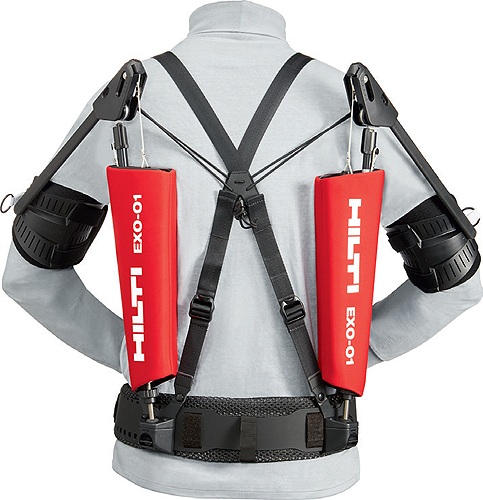
Take the strain
Overhead work in the construction industry is nothing new, but are we fully aware of the potential damage it’s doing to employees’ health and wellbeing? With reports in the UK stating that 498,000 workers suffered from musculoskeletal injuries in 2018/191, it’s worth considering how this will impact the industry as a whole, and whether there’s a solution to what often seems like an unavoidable problem.
Despite growing automation, there will always be tasks that need to be completed by humans – either because automation isn’t possible or the associated costs are too high. Overhead work is an example of this, but means biomechanical demands and extreme postures are repeatedly exceeding a worker’s physical capacity. What exactly does this mean for businesses and their employees?
Injured workers
If workers raise their arms over a 90° angle for more than ten percent of their working hours, the risk of musculoskeletal injuries in the shoulder region increases by one to two thirds2. This makes the construction industry one of the most dangerous sectors to work in regarding these types of injuries3. This is quite alarming, not only for workers and their health concerns, but also the knock-on effect it may have on a company’s reputation. Employers have a duty to protect their workers under the Health and Safety at Work Act, so will likely have questions on how they can reduce these risks.
Reduced jobsite productivity
There are many implications and setbacks if members of your workforce are injured, especially in terms of productivity. According to statistics from the UK government agency, Health and Safety Executive (HSE), 8.9 million working days were lost due to work-related musculoskeletal injuries in 2019/204. With less hands on deck to get the job done, companies will likely face lengthy project delays – an unforgiving roadblock for an industry that’s governed by the clock. Extra time will also be needed to recruit replacement workers and bring them up to speed, which of course incurs financial costs. In fact, reports show that musculoskeletal injuries cost construction employers approximately £646 million a year5 – including sick pay expenses and hefty fines for missed deadlines.
Aside from the obvious productivity losses that come from a reduced workforce, there’s also the issue of ‘presenteeism’, which occurs when employees continue to work when injured out of fear of losing their job. Unsurprisingly, this also has the tendency to drive down productivity, as workers are unable to give 100 percent. In an industry where time is money, we mustn’t underestimate the impact musculoskeletal injuries will have if they continue to effect employees’ health and wellbeing.
Skilled labor shortages
The construction industry has what is considered to be an ageing workforce, as the number of workers over the age of 60 is growing more than any other age group6. This, paired with an increased risk of muscle strain, doesn’t paint a particularly hopeful picture. And with an overall decline in the number of younger workers joining the industry, it’s looking more and more likely that a skilled labor shortage may be on the horizon. With this a possibility, businesses can’t afford to sit back and let musculoskeletal injuries reduce their workforces further. The real question is: How do we keep current workers in the industry whilst attracting new ones? Providing a safer working environment would go some way to satisfying both criteria.
Is there a solution?
Whilst overhead work is still dependent on humans, new innovations are introducing human augmentation systems to ease the physical demands of repetitive and strenuous tasks. The Hilti EXO-01 exoskeleton, for example, can be used to support workers’ upper limbs through assistive torques. The wearable system has been proven to lessen the load on muscles and joints when completing overhead work, with experiments showing a reduced amplitude of 40-48 percent for all segments of the deltoid and biceps brachii muscles7.
Hilti Health & Safety expert, Saskia Duch, says: “One of the key reasons for health-related absences from work in the construction industry is musculoskeletal injuries. With it having such a significant impact on workers’ health and income, as well as a project’s delivery time and financial situation, we must do our best to prevent these injuries from occurring. This can be done through designing out the risk in the first place, or by adopting new technologies and ways of working. One such example could be the use of the exoskeleton to reduce the strain placed on the upper body muscles, ultimately minimizing the risk of musculoskeletal injury.”
1 HSE, Health and Safety at Work: Summary Statistics for Great Britain, 2019
2 Grieve J, Dickerson C., Overhead work: Identification of Evidence-based Exposure Guidelines. Occupational Ergonomics, 2008; 1: 53–66
3 HSE, Construction Statistics in Great Britain, 2020
4 HSE, Work related musculoskeletal disorder statistics (WRMSDs) in Great Britain, 2020
5 CIOB, The Impact of the Ageing Population on the Construction Industry, 2009
6 Ottobock with Paexo Shoulder, Principle study about the effect of an industrial exoskeleton on overhead work
Hilti designs and manufactures leading-edge technology, software and services, which power the professional construction industry. It is global, based in over 120 countries with more than 30,000 employees. Everyday its technologies support awe-inspiring feats of engineering around the world – from the famous bullet train in Japan to tunnels deep under some of the largest cities on earth. It offers a 360-degree service for the construction industry – from design software, products and tools onsite to training, repairs, testing and consultancy. It is a one-stop shop for building, worldwide.
www.hilti.co.uk